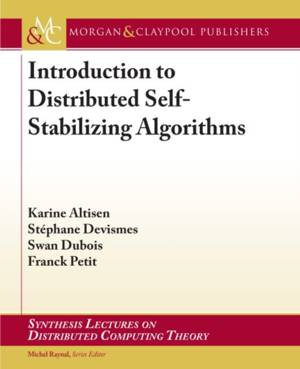
- Afhalen na 1 uur in een winkel met voorraad
- Gratis thuislevering in België vanaf € 30
- Ruim aanbod met 7 miljoen producten
- Afhalen na 1 uur in een winkel met voorraad
- Gratis thuislevering in België vanaf € 30
- Ruim aanbod met 7 miljoen producten
Introduction to Distributed Self-Stabilizing Algorithms
Karine AltisenOmschrijving
This book aims at being a comprehensive and pedagogical introduction to the concept of self-stabilization, introduced by Edsger Wybe Dijkstra in 1973.
Self-stabilization characterizes the ability of a distributed algorithm to converge within finite time to a configuration from which its behavior is correct (i.e., satisfies a given specification), regardless the arbitrary initial configuration of the system. This arbitrary initial configuration may be the result of the occurrence of a finite number of transient faults. Hence, self-stabilization is actually considered as a versatile non-masking fault tolerance approach, since it recovers from the effect of any finite number of such faults in a unified manner. Another major interest of such an automatic recovery method comes from the difficulty of resetting malfunctioning devices in a large-scale (and so, geographically spread) distributed system (the Internet, Pair-to-Pair networks, and Delay Tolerant Networks are examples of such distributed systems). Furthermore, self-stabilization is usually recognized as a lightweight property to achieve fault tolerance as compared to other classical fault tolerance approaches. Indeed, the overhead, both in terms of time and space, of state-of-the-art self-stabilizing algorithms is commonly small. This makes self-stabilization very attractive for distributed systems equipped of processes with low computational and memory capabilities, such as wireless sensor networks.
After more than 40 years of existence, self-stabilization is now sufficiently established as an important field of research in theoretical distributed computing to justify its teaching in advanced research-oriented graduate courses. This book is an initiation course, which consists of the formal definition of self-stabilization and its related concepts, followed by a deep review and study of classical (simple) algorithms, commonly used proof schemes and design patterns, as well as premium results issued from the self-stabilizing community. As often happens in the self-stabilizing area, in this book we focus on the proof of correctness and the analytical complexity of the studied distributed self-stabilizing algorithms.
Finally, we underline that most of the algorithms studied in this book are actually dedicated to the high-level atomic-state model, which is the most commonly used computational model in the self-stabilizing area. However, in the last chapter, we present general techniques to achieve self-stabilization in the low-level message passing model, as well as example algorithms.
Specificaties
Betrokkenen
- Auteur(s):
- Uitgeverij:
Inhoud
- Aantal bladzijden:
- 165
- Taal:
- Engels
- Reeks:
Eigenschappen
- Productcode (EAN):
- 9781681735368
- Verschijningsdatum:
- 15/04/2019
- Uitvoering:
- Paperback
- Formaat:
- Trade paperback (VS)
- Afmetingen:
- 190 mm x 235 mm
- Gewicht:
- 294 g

Alleen bij Standaard Boekhandel
Beoordelingen
We publiceren alleen reviews die voldoen aan de voorwaarden voor reviews. Bekijk onze voorwaarden voor reviews.











